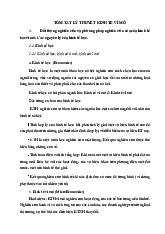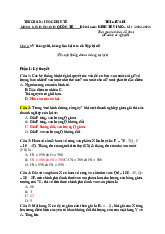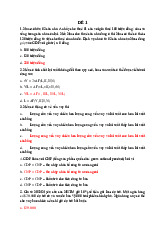



















Preview text:
¶ Macroeconomics
C = Consumer ( những cái chi tiêu cho final goods )
1. The total income of everybody in the economy
2. The total expenditure on the economy’s output of goods and services (tổng chi tiêu cho sản lượng hàng hoá và dịch vụ của nền kinh tế)
Income must equal expenditure because : the expenditure of buyers on products is income to the sellers of those products
National income accounting: the system used to measure GDP and many related statistics. Real GDP National GDP GDP deflation CPI STOCKS AND FLOWS
Stock (trữ lượng): a quantity measured at a given point in time Flow
(lưu lượng): a quantity measured per unit of time.
NOMINAL GDP AND REAL GDP
GDP tăng lên từ năm này sang năm khác thì có 2 trường hợp xảy ra:
1. Nền kinh tế đang sản xuất lượng hàng hoá và dịch vụ lớn hơn
2. Hàng hoá và dịch vụ đang được bán với giá cao hơn
Muốn tách bạch hai thứ này (tức là muốn tính xem lượng hàng hoá và dịch vụ mà nền kinh tế sản xuất ra nhưng không bị ảnh
hưởng bởi giá cả/tính theo mức giá cố định của những hàng hoá và dịch vụ đó )
A better measure of economic well-being would tally the economy’s output of goods and services without being influenced
by changes/using a constant set of prices
Real GDP shows what would have happened to expenditure on output if quantities had changed but prices had not.
Nominal GDP for 2010, 2011 and 2012 are: 200USD → 600USD → 1200USD
Gia tăng GDP vì: Quantities increased and also Prices
HOW REAL GDP IS COMPUTED??
Begin with choosing a set of prices, called base-year prices (năm cơ sở), such as the prices prevailing in 2010. Goods and
services are then added up by using these base-year prices to value the different goods in each year. Real GDP in 2011 would be: 350
The GDP Deflator (Chỉ số giảm phát GDP)
- Nominal GDP is the marked value of final goods and services produces in a country in a time period
Real GDP is the marked value of the ouput goods and services without being influenced by prices GDP
DEFLATOR: Phản ánh giá cả của hàng hoá và dịch vụ CPI
CPI = Cost of basket (present) / Cost of basket (base-year) * 100
Spending habit of typical consumer (food, transportation, housing…): thói quen tiêu dùng
A few problems in CPI calculation:
1. Substitution (after identifying spending habits of a typical consumer, you will know how much that consumer spent
on goods - when the prices increase, the consumer probably change their habits) 2. Quality of life Question 1:
Nominal GDP = 150.000 = Price * Quantity
(100*100)+(200*300)+(2000*20)+(20000*2)
Real GDP = 133.000 = Base year Price * Quantity
(80*100)+(150*300)+(2200*20)+(18000*2)=133.000 Question 2: Cost of basket
2022: (5000*1)+(200*20)+(2000*1)+(10*200)=13.000 2021:
(4500*1)+(150*20)+(2100*1)+(12*200)=12.000 CPI
2022: [13.000 / (1*4000) + (120*20)+(2100*1)+(8*200)] *100 = 128.71
2021: 12.000 / 10.100 * 100 = 118.81 Inflation
2022 inflation = [ (128.71 - 118.81) / 118.81 ] * 100 =8.33 Question 3:
Vì CPI phản ánh mức độ thay đổi giá cả của sản phẩm tiêu thụ, việc tính toán CPI cũng có 1 vấn đề là không thể phản ánh
được sự thay đổi về số lượng và chất lượng của giỏ hàng nên thay đổi máy móc cũng k ảnh hưởng đến CPI quá nhiều. Còn
GDP vì GDP được tính bởi 2 yếu tố là số lượng và giá cả nhưng giá cả không phản ánh sức mạnh của 1 nền kinh tế mà phụ
thuộc vào số lượng, Nếu tăng lượng máy thì số lượng tăng nên GDP tăng theo.
CHAPTER 3 FLOW ECONOMY AND PRODUCTION FUNCTION
CHAPTER 4: SAVING AND INVESTMENT Investment Saving Interest rate
What are the main types of financial institutions in the U.S. economy, and what is their function?
What are the three kinds of saving?
What’s the difference between saving and investment?
How does the financial system coordinate saving and investment?
How do govt policies affect saving, investment, and the interest rate? Financial Institutions
The financial system (Định chế tài chính): the group of institutions that helps match the saving of one person with the investment of another.
Financial Markets: Institutions through which savers directly provide funds to borrowers.
Ex: The bond market (is a certificate of indebtedness)
The stock market (A stock is a claim to partial ownership in a firm)
Financial Intermediaries: Institutions through which savers can indirectly provide funds to borrowers.
Financial intermediaries include financial instutions and banks that act as a bridge between lenders and borrowers.
Lenders are people who have money and want to invest. Borrowers are people who need money to invest. Ex: - Banks
- Mutual funds (quỹ tương hỗ) - Institutions that sell shares to the public and use the proceeds (tiền thu được) to buy
portfolios of stocks and bonds
- People deposit money into saving account or term deposit and banks use this fund to lend to companies Stock Market
Companies can issue share to raise capital from the general public. People who hold share of a company will become a
shareholder of a company. In many cases, shareholders will have voting right in a company.
Shareholders can either get back their investment by selling share or receive dividend
CHAP 5: MONEY AND MONEY MULTIPLIER
CHAPTER 6: UNEMPLOYMENT
CHAPTER 7: OPEN ECONOMY




